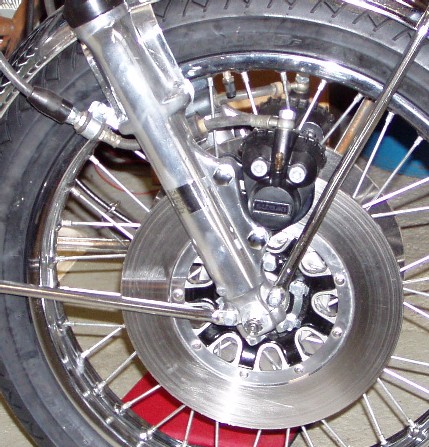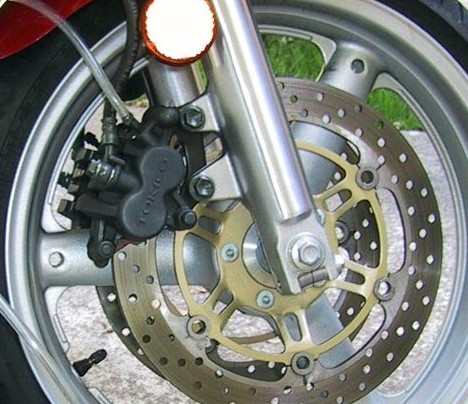The stock OEM brakes on a GT750 were described in at least one motorcycle magazine of the time as outstanding. The question that begs is "compared to what"? Stainless steel disk material didn't have the highest coefficient of friction but was chosen so that it didn't rust and make the bike look awful. That was the design fear when these bikes were appearing with disk brakes for the first time. No rusty looking disks here, thank you very much.
Calipers were single piston sliding design which meant that the whole caliper had to slide to make the bakes work and over time they stopped sliding and the brakes deteriorated markedly. That single caliper design was a copy of the Honda CB750 and was state of the art for the time. Sliding caliper is not a bad design and is still used on most cars and many bikes.
In fact many motorcycles still use that basic design, but it has been refined and now works very well with two pistons in lieu of those original singles.
|
Stock GT750 brake calipers and heavy disks |
2003 Suzuki SV650 twin piston calipers and light disks |
SV650 or GSXR disks would be nice, but they use a 5 bolt fixing pattern and that would require more machining. I happened to have a pair of Honda disks that were purchased for a different project and by luck, the bolt pattern is the same as a GT750 (and a CBR900RR), but the bolt holes were 6mm and that was easy to change to suit GT750 8mm bolts. The dish or offset also happened to be almost the same.
The next issue to resolve was calipers. I tried a couple of different years of GSXR 4 piston calipers from Nissin and Tokico but they were all too thick and fouled the spokes. I borrowed a Brembo Gold Line racing caliper which is much more narrow and it would have worked - but at a hefty price in excess of the total budget. That upgrade can wait until I win the lottery. One of these days I must remember to buy a ticket!
Next to be tried were a pair Honda CBR600 calipers, but their mounting brackets are strange, so they were sold again. Eventually I decided on SV650 and picked up a pair cheaply on that auction site we all love to hate.
Among Kawasaki triple owners a popular upgrade is to fit calipers from the EX500 which are very similar to SV650. On a Kawasaki triple, accepted wisdom is that a single caliper with stock stainless disk is enough stopping power. On the heavier (and faster ?) GT750, current thinking seems to be that two disks are better than one. I'd prefer a single disk for the simpler Flat Track look if possible.
So why go to all this bother? Two reasons weight and barking performance.
A stock wheel complete with axle and two disks weighs about 36.6 pounds. Taking off those heavy stock disks leaves a reasonable 23.4 pounds for the wheel and axle and spacers and the tire and tube. That is not bad, even by modern standards. Fitting just a single light disk raises the weight to 26.0 pounds - a saving of 10.6 pounds compared to stock.
That's almost a third of total wheel weight! So, if possible I'd like to run it with a single disk and caliper. If the bike is still too heavy (or too fast) for that single sided brake, we can add the other disk and caliper and fit a suitable master cylinder.
Reducing unsprung weight improves suspension as well as overall performance, so with any luck it will stop, accelerate and handle better too.
This spacer was machined out of 6061 Aluminum by our tool and die guy at KTM machining in Elk Grove Village.
Placing the CBR600 disk over the GT750 porker. it's easy to see the weight difference in thickness, aluminum carrier and the place where the aluminum stops and steel starts. There is so much less material in a modern disk.
The SV650 calipers were stripped to get to the steel mounting brackets

